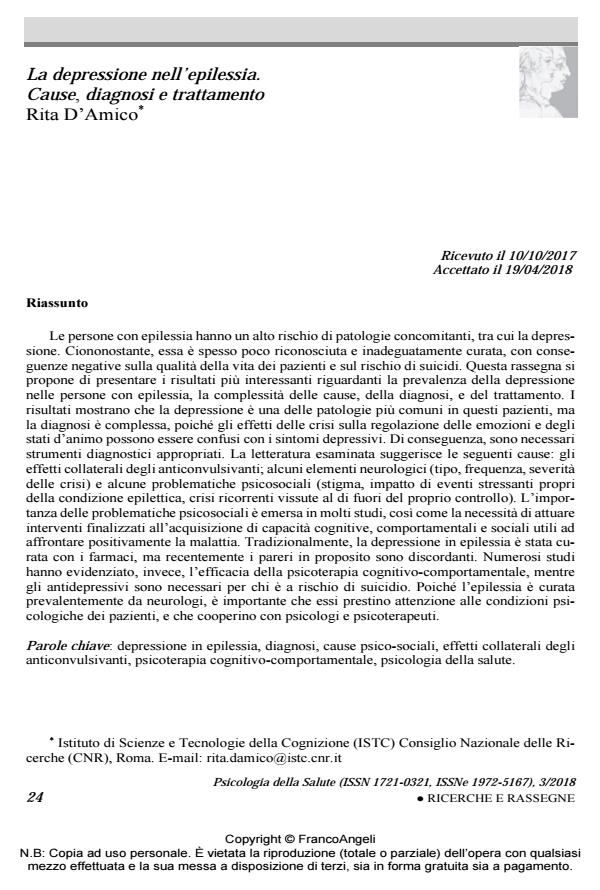La depressione nell’epilessia. Cause, diagnosi e trattamento
Titolo Rivista PSICOLOGIA DELLA SALUTE
Autori/Curatori Rita D’Amico
Anno di pubblicazione 2018 Fascicolo 2018/3
Lingua Italiano Numero pagine 20 P. 24-43 Dimensione file 251 KB
DOI 10.3280/PDS2018-003002
Il DOI è il codice a barre della proprietà intellettuale: per saperne di più
clicca qui
Qui sotto puoi vedere in anteprima la prima pagina di questo articolo.
Se questo articolo ti interessa, lo puoi acquistare (e scaricare in formato pdf) seguendo le facili indicazioni per acquistare il download credit. Acquista Download Credits per scaricare questo Articolo in formato PDF

FrancoAngeli è membro della Publishers International Linking Association, Inc (PILA)associazione indipendente e non profit per facilitare (attraverso i servizi tecnologici implementati da CrossRef.org) l’accesso degli studiosi ai contenuti digitali nelle pubblicazioni professionali e scientifiche
Le persone con epilessia hanno un alto rischio di patologie concomitanti, tra cui la de-pressione. Ciononostante, essa è spesso poco riconosciuta e inadeguatamente curata, con conseguenze negative sulla qualità della vita dei pazienti e sul rischio di suicidi. Questa ras-segna si propone di presentare i risultati più interessanti riguardanti la prevalenza della de-pressione nelle persone con epilessia, la complessità delle cause, della diagnosi, e del tratta-mento. I risultati mostrano che la depressione è una delle patologie più comuni in questi pa-zienti, ma la diagnosi è complessa, poiché gli effetti delle crisi sulla regolazione delle emozioni e degli stati d’animo possono essere confusi con i sintomi depressivi. Di conseguenza, sono necessari strumenti diagnostici appropriati. La letteratura esaminata suggerisce le seguenti cause: gli effetti collaterali degli anticonvulsivanti; alcuni elementi neurologici (tipo, frequenza, severità delle crisi) e alcune problematiche psicosociali (stigma, impatto di eventi stressanti propri della condizione epilettica, crisi ricorrenti vissute al di fuori del proprio controllo). L’importanza delle problematiche psicosociali è emersa in molti studi, così come la necessità di attuare interventi finalizzati all’acquisizione di capacità cognitive, comportamentali e sociali utili ad affrontare positivamente la malattia. Tradizionalmente, la depressione in epilessia è stata curata con i farmaci, ma recentemente i pareri in proposito sono discordanti. Numerosi studi hanno evidenziato, invece, l’efficacia della psicoterapia cognitivo-comportamentale, mentre gli antidepressivi sono necessari per chi è a rischio di suicidio. Poiché l’epilessia è curata prevalentemente da neurologi, è importante che essi prestino attenzione alle condizioni psicologiche dei pazienti, e che cooperino con psicologi e psicoterapeuti.
Parole chiave:Depressione in epilessia, diagnosi, cause psico-sociali, effetti collaterali degli anticonvulsivanti, psicoterapia cognitivo-comportamentale, psicologia della salute.
Rita D’Amico, La depressione nell’epilessia. Cause, diagnosi e trattamento in "PSICOLOGIA DELLA SALUTE" 3/2018, pp 24-43, DOI: 10.3280/PDS2018-003002